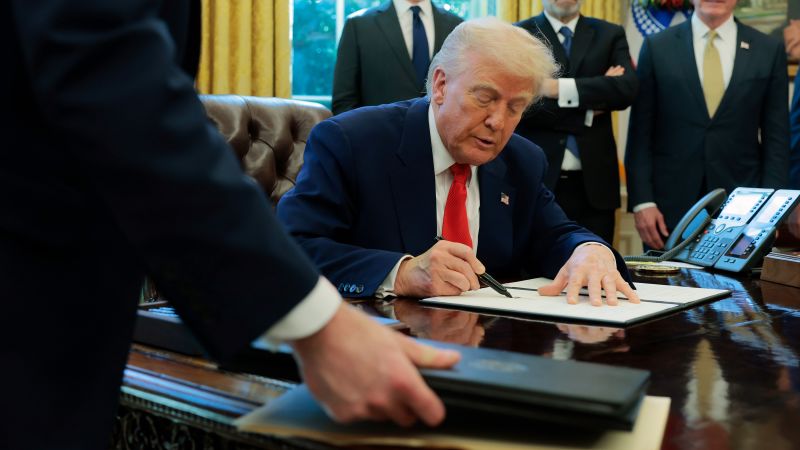In the contentious arena of global trade, President Donald Trump and his administration have pursued an audacious strategy: the imposition of exorbitant tariffs aimed at stirring fear amongst other nations and compelling them to negotiate. This controversial approach is intended, with the exception of China, to see America retract the harshest trade restrictions while simultaneously drafting new agreements across various international borders. This plan, however, faces monumental challenges, especially as it requires the Trump administration to navigate an intricate web of trade relationships within a mere span of 90 days before the tariffs bite.
Markets have reacted to these machinations with skepticism—financial stocks ebbed and flowed in erratic patterns, a reflection of deeper uncertainties that ripple through the broader economy. For instance, in the wake of a fresh clarification regarding China’s tariff, which rose unexpectedly from what was previously reported, stock prices experienced a staggering plunge. The Dow Jones Industrial Average, an enduring bellwether of market health, witnessed tumultuous swings, emphasizing the volatility characterized by the turmoil of the trade narrative. Despite some recovery, including a notable 450-point increase at one stage, investors remain on edge due to the inherent unpredictability of any announcements from Trump’s administration.
Beyond the equity markets, the bond market is exhibiting atypical behavior. Generally, during periods of economic turbulence, one would anticipate an increase in bond prices, given their status as stable investments backed by the U.S. government’s full faith and credit. Surprisingly, however, U.S. Treasury bonds have experienced a decline in price, signifying that market participants are losing confidence in the current trade policy and its potential repercussions for the U.S. economy. Notably, surging yields on U.S. Treasuries have reached levels exceeding 4.5%, a considerable jump from earlier in the week. Such movements suggest rising costs for consumer loans, which are closely tied to these interest rates, potentially hampering economic growth.
Simultaneously, the oil market reflects apprehensions surrounding an impending recession, as prices have plummeted to nearly four-year lows. Investors appear concerned that Trump’s aggressive tariff strategy may curb demand across various sectors reliant on fuel, including travel and transportation. Historical precedents indicate that oil prices can serve as indicators of economic downturns, further feeding into the narrative of a fragile market.
Compounding these issues is the unexpected decline in the value of the dollar, which recently fell to a three-year low. Conventional economic wisdom suggests that tariffs should bolster domestic currency value; however, market sentiment indicates a stark contrast. Traders appear convinced that the repercussions of Trump’s trade policies could leave the U.S. economy weakened, leading to a sell-off of the dollar. This shift has seen the dollar index—tracking its strength against a basket of currencies—notably decrease, reflecting wider concerns regarding the U.S. economic landscape.
Amidst these turbulent times, gold prices have surged as investors flock towards safe-haven assets amidst fears of financial chaos. Sharp increases in gold prices, recently eclipsing record highs, are indicative of the growing uncertainty and pressurized conditions facing traditional financial markets.
Ironically, despite the dire forecasts and tumultuous market conditions, the Trump administration maintains a veneer of optimism. Treasury Secretary Scott Bessent recently highlighted that more than 70 countries have expressed interest in negotiating solutions to mitigate the impact of the tariffs, with potential discussions favoring allies such as South Korea and Japan. However, it’s essential to recognize that trade negotiations are inherently intricate, often taking years to finalize—a stark contrast to the administration’s timeline. Furthermore, the elephant in the room remains China, whose significant retaliatory tariffs underscore the complexities of the situation.
Overall, this environment, marked by uncertainty and disquiet within the markets, has sparked stark divisions among economists. Although future trade agreements could provide a modicum of relief, the prevailing sentiment holds that pervasive, lasting damage has already been inflicted, casting a shadow over both U.S. and global economic trajectories. According to analysts at JPMorgan Chase and Goldman Sachs, fears of recession loom large, with odds of economic downturn appearing almost evenly split, reflecting the apprehensive climate that prevails amidst the evolving trade discourse. As the situation continues to unfold, the coming months will prove pivotal in shaping the future of American trade policies and their ramifications on the global front.



